 W
WThe Battle of Abensberg took place on 20 April 1809 between a Franco-German force under the command of Emperor Napoleon I of France and a reinforced Austrian corps led by Feldmarschall-Leutnant Archduke Louis of Austria. As the day wore on, Feldmarschall-Leutnant Johann von Hiller arrived with reinforcements to take command of the three corps that formed the Austrian left wing. The action ended in a complete Franco-German victory. The battlefield was southeast of Abensberg and included clashes at Offenstetten, Biburg-Siegenburg, Rohr in Niederbayern, and Rottenburg an der Laaber. On the same day, the French garrison of Regensburg capitulated.
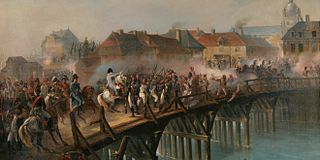 W
WThe Battle of Arcis-sur-Aube saw an Imperial French army under Napoleon face a much larger Allied army led by Karl Philipp, Prince of Schwarzenberg during the War of the Sixth Coalition. On the second day of fighting, Emperor Napoleon suddenly realized he was massively outnumbered, and immediately ordered a masked retreat. By the time the Austrian Field Marshal Schwarzenberg realized Napoleon was retreating, most of the French had already disengaged and the Allied pursuit afterwards failed to prevent the remaining French army from safely withdrawing to the north. This was Napoleon's penultimate battle before his abdication and exile to Elba, the last being the Battle of Saint-Dizier.
 W
WThe Battle of Kissingen was a battle between Bavarian and Prussian troops on 10 July 1866 during the Austrian-Prussian War in and around the town Kissingen in Bavaria. It was part of the campaign of the Main and ended with a victory of the Prussians.
 W
WThe Siege of Belgrade in 1688 was the fourth siege of that city, taking place during the Great Turkish War.
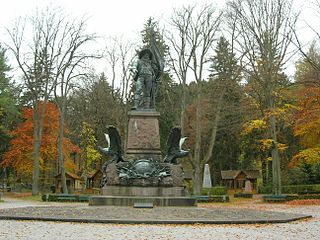 W
WThe Battles of Bergisel were four battles fought between the forces of Emperor Napoleon I of France and the Kingdom of Bavaria against Tyrolese militiamen and a contingent of Austrian regular soldiers at the Bergisel hill near Innsbruck. The battles, which occurred on 25 May, 29 May, 13 August, and 1 November 1809, were part of the Tyrolean Rebellion and the War of the Fifth Coalition.
 W
WThe Battle of Blenheim, fought on 13 August 1704, was a major battle of the War of the Spanish Succession. The overwhelming Allied victory ensured the safety of Vienna from the Franco-Bavarian army, thus preventing the collapse of the reconstituted Grand Alliance.
 W
WThe Campaign of the Main was a campaign of the Prussian army in the area of the river Main against the allies of Austria in Southern Germany during the Austro-Prussian War of 1866.
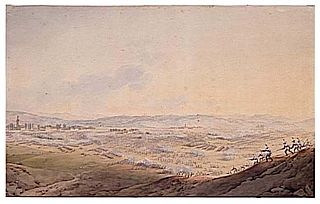 W
WThe Battle of Eckmühl, fought on 21 April – 22 April 1809, was the turning point of the 1809 Campaign, also known as the War of the Fifth Coalition. Napoleon I had been unprepared for the start of hostilities on 10 April 1809, by the Austrians under the Archduke Charles of Austria and for the first time since assuming the French Imperial Crown had been forced to cede the strategic initiative to an opponent. Thanks to the dogged defense waged by the III Corps, commanded by Marshal Davout, and the Bavarian VII Corps, commanded by Marshal Lefebvre, Napoleon was able to defeat the principal Austrian army and wrest the strategic initiative for the remainder of the war.
 W
WThe Battle of Fère-Champenoise was fought between two Imperial French corps led by Marshals Auguste de Marmont and Édouard Mortier, duc de Trévise and a larger Coalition force composed of cavalry from the Austrian Empire, Kingdom of Prussia, Kingdom of Württemberg, and Russian Empire. Caught by surprise by Field Marshal Karl Philipp, Prince of Schwarzenberg's main Coalition army, the forces under Marmont and Mortier were steadily driven back and finally completely routed by aggressive Allied horsemen and gunners, suffering heavy casualties and the loss of most of their artillery. Two divisions of French National Guards under Michel-Marie Pacthod escorting a nearby convoy were also attacked and wiped out in the Battle of Bannes. The battleground was near the town Fère-Champenoise located 40 kilometres (25 mi) southwest of Châlons-en-Champagne.
 W
WThe Siege of Fort-Louis saw a force composed of Habsburg Austrians, Hessians and Bavarians led by Franz von Lauer lay siege to Fort-Louis which was held by a Republican French garrison under Michel Durand. The French capitulated after a defense lasting exactly one month. The siege occurred during the War of the First Coalition, part of the French Revolutionary Wars. In 1793 the fortress was sited on an island in the Rhine River, but today Fort-Louis is a village in the Bas-Rhin department in France.
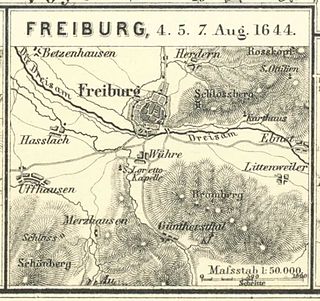 W
WThe Battle of Freiburg, also called the Three Day Battle, took place on 3, 5 and 9 August 1644 as part of the Thirty Years' War. It took place between the French, consisting of a 20,000 men army, under the command of Louis II de Bourbon: the Prince of Condé and Henri de La Tour d'Auvergne: Viscount de Turenne, and a Bavarian-Imperial army of 16,000 men under Field Marshal Franz von Mercy. On 3 and 5 August, the French suffered heavy casualties despite having greater numbers. On the 9th, Turenne’s army flanked the Bavarians by heading to Glottertal through Betzenhausen and cutting off their supplies, where they faced off against each other, with the latter suffering heavy casualties. The battle resulted in both parties losing approximately 7,500 men, and the outcome was inconclusive, as the Bavarians retreated due to lack of supplies and the sheer greater numbers of the French. Following this battle, the French took advantage of the retreating Bavarians by conquering a large part of the Upper Rhine region. Consequently, in 1645, Battle of Nördlingen was fought between the same parties which resulted in the victory for the French.
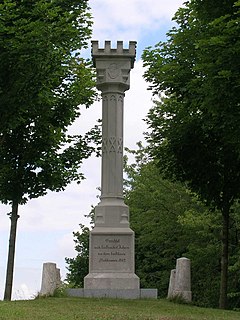 W
WThe Battle of Gammelsdorf took place in November 1313. The cause of the skirmish was the guardianship of the underage duke of Lower Bavaria. This was sought by both Duke Louis the Bavarian and Duke Frederick I of Austria. It circled around the question of who would execute tutelage over the minor children of the late Lower Bavarian Dukes, thus also commanding the tremendous economic power of that region. Their Upper Bavarian cousin, Duke Louis, the later Emperor Louis IV, the Bavarian, as agreements within the several branches of the Bavarian line of the House of Wittelsbach determined and as the burghers of the Lower Bavarian cities wanted to see it done, or Duke Frederick I of Austria, the Fair, also Louis' cousin, both having been raised and educated together in Vienna.
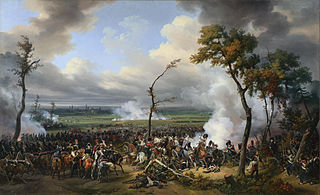 W
WThe Battle of Hanau was fought from 30 to 31 October 1813 between Karl Philipp von Wrede's Austro-Bavarian corps and Napoleon's retreating French during the War of the Sixth Coalition.
 W
WThe Battle of Herbsthausen, also known as the Battle of Mergentheim, took place near Bad Mergentheim, in the modern German state of Baden-Württemberg. Fought on 2 May 1645, during the Thirty Years War, it featured a French army led by Turenne, and a Bavarian force under Franz von Mercy.
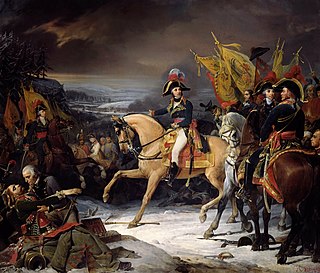 W
WThe Battle of Hohenlinden was fought on 3 December 1800, during the French Revolutionary Wars. A French army under Jean Victor Marie Moreau won a decisive victory over the Austrians and Bavarians led by Archduke John of Austria. After being forced into a disastrous retreat, the allies were compelled to request an armistice that effectively ended the War of the Second Coalition. Hohenlinden is 33 km east of Munich in modern Germany.
 W
WThe Battle of La Rothière was fought on the 1st of February 1814 between the French Empire and allied army of Austria, Prussia, Russia, and German States previously allies with France. The French were led by Emperor Napoleon and the coalition army was under the command of Gebhard Leberecht von Blücher. The battle took place in severe weather conditions. The French were defeated but managed to hold until they could retreat under cover of darkness.
 W
WThe Battle of Landshut took place on 21 April 1809 between the French, Württembergers and Bavarians under Napoleon which numbered about 77,000 strong, and 36,000 Austrians under the General Johann von Hiller. The Austrians, though outnumbered, fought hard until Napoleon arrived, when the battle subsequently became a clear French victory.
 W
WThe Battle of Laubressel saw the main Allied army of Field Marshal Karl Philipp, Prince of Schwarzenberg mount a three-pronged converging attack on the weaker army of Marshal Jacques MacDonald. The French forces under Marshal Nicolas Oudinot bore the brunt of the fighting, in which the Allies tried to turn their left flank. The French abandoned Troyes and retreated west as a result of the action. The village of Laubressel is located 10 kilometres (6 mi) east of Troyes.
 W
WThe Battle of Lesmont was a battle of the War of the Sixth Coalition. It took place at Lesmont in Aube on 2 February 1814. A Coalition force of Russians and Bavarians under generals Eugen of Wurtemberg and Carl Philipp von Wrede was defeated by a French force under general Joseph Lagrange, which managed to destroy the town's bridge and prevent the Coalition force crossing the river Aube.
 W
WThe Battle of Malplaquet was fought near the border of France on 11 September 1709 and was a major engagement of the War of the Spanish Succession. It pitted a French army, commanded by Marshal Duke of Villars and Marshal Duke of Boufflers, against an allied army, led by the Duke of Marlborough and Prince Eugene of Savoy. After a string of defeats, failure of the harvest and the prospect of invasion, Louis XIV of France had appealed to French patriotism, recruited fresh soldiers and instructed Villars to use the country's last army to give battle against Marlborough's formidable force. After a series of manoeuvres, Villars settled on a position in which both of his flanks were anchored in woods. Even though the French were outnumbered, Marlborough's familiar tactics of flank attacks to draw off troops from the centre incurred serious attrition by massed French musketry and skillful use of artillery.
 W
WThe Battle of Mohács was one of the most consequential battles in Central European history. It was fought on 29 August 1526 near Mohács, Kingdom of Hungary, between the forces of the Kingdom of Hungary and its allies, led by Louis II, and those of the Ottoman Empire, led by Suleiman the Magnificent. The Ottoman victory led to the partition of Hungary for several centuries between the Ottoman Empire, the Habsburg Monarchy, and the Principality of Transylvania. Further, the death of Louis II as he fled the battle marked the end of the Jagiellonian dynasty in Hungary and Bohemia, whose dynastic claims passed to the House of Habsburg. The Battle of Mohács marked the end of the Middle Ages in Hungary.
 W
WThe Battle of Mormant was fought during the War of the Sixth Coalition between an Imperial French army under Emperor Napoleon I and a division of Russians under Count Peter Petrovich Pahlen. Enveloped by cavalry led by François Étienne de Kellermann and Édouard Jean-Baptiste Milhaud and infantry led by Étienne Maurice Gérard, Pahlen's outnumbered force was nearly destroyed, with only about a third of its soldiers escaping. Later in the day, a French column led by Marshal Claude Perrin Victor encountered an Austrian-Bavarian rearguard under Anton Leonhard von Hardegg and Peter de Lamotte in the Battle of Valjouan. Attacked by French infantry and cavalry, the Allied force was mauled before it withdrew behind the Seine River. The Mormant-Valjouan actions and the Battle of Montereau the following day marked the start of a French counteroffensive intended to drive back Karl Philipp, Prince of Schwarzenberg's Allied Army of Bohemia. The town of Mormant is located 50 kilometres (31 mi) southeast of Paris.
 W
WThe Battle of Mühldorf was fought near Mühldorf am Inn on September 28, 1322 between the Duchy of (Upper) Bavaria and Austria. The Bavarians were led by the German king Louis of Wittelsbach, while the Austrians were under the command of his cousin, the anti-king Frederick of Habsburg.
 W
WThe Battle of Neumarkt-Sankt Veit on 24 April 1809 saw a Franco-Bavarian force led by Marshal Jean-Baptiste Bessières face an Austrian Empire army commanded by Johann von Hiller. Hiller's numerically superior force won a victory over the Allied troops, forcing Bessières to retreat to the west. Neumarkt-Sankt Veit is located ten kilometers north of Mühldorf and 33 kilometers southeast of Landshut in Bavaria.
 W
WThe second Battle of Nördlingen was fought on August 3, 1645 southeast of Nördlingen near the village of Alerheim. France and its Protestant German allies defeated the forces of the Holy Roman Empire and its Bavarian Catholic league allies.
 W
WThe Battle of Paris was fought on March 30–31, 1814 between the Sixth Coalition, consisting of Russia, Austria, and Prussia, against the French Empire. After a day of fighting in the suburbs of Paris, the French surrendered on March 31, ending the War of the Sixth Coalition and forcing Emperor Napoleon to abdicate and go into exile.
 W
WThe Battle of Pfaffenhofen was fought on 15 April 1745 between France and Austria. The Austrians under Karl Josef Batthyány defeated the outnumbered French under General Ségur, ending the war in Bavaria.
 W
WThe Battle of Pressburg or Battle of Pozsony, or Battle of Bratislava was a three-day-long battle, fought between 4–6 July 907, during which the East Francian army, consisting mainly of Bavarian troops led by Margrave Luitpold, was annihilated by Hungarian forces.
 W
WThe Battle of Ramillies, fought on 23 May 1706, was a battle of the War of the Spanish Succession. For the Grand Alliance – Austria, England, and the Dutch Republic – the battle had followed an indecisive campaign against the Bourbon armies of King Louis XIV of France in 1705. Although the Allies had captured Barcelona that year, they had been forced to abandon their campaign on the Moselle, had stalled in the Spanish Netherlands and suffered defeat in northern Italy. Yet despite his opponents' setbacks Louis XIV wanted peace, but on reasonable terms. Because of this, as well as to maintain their momentum, the French and their allies took the offensive in 1706.
 W
WThe Battle of Schellenberg, also known as the Battle of Donauwörth, was fought on 2 July 1704 during the War of the Spanish Succession. The engagement was part of the Duke of Marlborough's campaign to save the Habsburg capital of Vienna from a threatened advance by King Louis XIV's Franco-Bavarian forces ranged in southern Germany. Marlborough had commenced his 250-mile (400 km) march from Bedburg, near Cologne, on 19 May; within five weeks he had linked his forces with those of the Margrave of Baden, before continuing on to the river Danube. Once in southern Germany, the Allies' task was to induce Max Emanuel, the Elector of Bavaria, to abandon his allegiance to Louis XIV and rejoin the Grand Alliance; but to force the issue, the Allies first needed to secure a fortified bridgehead and magazine on the Danube, through which their supplies could cross to the south of the river into the heart of the Elector's lands. For this purpose, Marlborough selected the town of Donauwörth.
 W
WThe Battle of Sedan was fought during the Franco-Prussian War from 1 to 2 September 1870. Resulting in the capture of Emperor Napoleon III and large numbers of his troops, it effectively decided the war in favour of Prussia and its allies, though fighting continued under a new French government.
 W
WThe Siege of Godesberg, 18 November – 17 December 1583, was the first major siege of the Cologne War (1583–1589). Seeking to wrest control of an important fortification, Bavarian and mercenary soldiers surrounded the Godesberg, and the village then of the same name, now Bad Godesberg, located at its foot. On top of the mountain sat a formidable fortress, similarly named Godesburg, built in the early 13th century during a contest over the election of two competing archbishops.
 W
WThe Siege of Toul was the siege of the fortified French town of Toul from 16 August to 23 September 1870 by Prussian, Bavarian and Württemberg forces during the Franco-Prussian War. Toul controlled a railway line leading to Germany and it was vital for the Germans to secure it to resupply and reinforce their armies in northern France.
 W
WThe Battle of Tuttlingen was fought in Tuttlingen on 24 November 1643. Those involved in the conflict were the French forces led by Marshal Josias Rantzau and the armies of the Holy Roman Empire and Spain led by Franz von Mercy. Technically, Mercy led a military force composed of Imperial, Spanish, Bavarian, and Lorrainer troops.
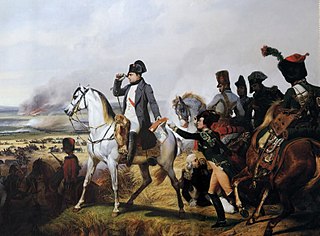 W
WThe Battle of Wagram was a military engagement of the Napoleonic Wars that ended in a costly but decisive victory for Emperor Napoleon Bonaparte's French and allied army against the Austrian army under the command of Archduke Charles of Austria-Teschen. The battle led to the breakup of the Fifth Coalition, the Austrian and British-led alliance against France.
 W
WThe Battle of Wissembourg or Battle of Weissenburg, the first of the Franco-Prussian War, was joined when three German army corps surprised the small French garrison at Wissembourg on 4 August 1870. The defenders, greatly outnumbered, fought stubbornly... especially considering they were surprised and greatly outnumbered, that the French sustained their old renown as fighting men and that the first defeat, although severe, reflected no discredit on the soldiers of the 1st Corps."
 W
WIn the Battle of Wörgl or Wörgel on 13 May 1809 a Bavarian force under French Marshal François Joseph Lefebvre attacked an Austrian Empire detachment commanded by Johann Gabriel Chasteler de Courcelles. The Bavarians severely defeated Chasteler's soldiers in series of actions in the Austrian towns of Wörgl, Söll, and Rattenberg. Wörgl is located 20 kilometres (12 mi) south of the modern-day German border on the upper Inn River.